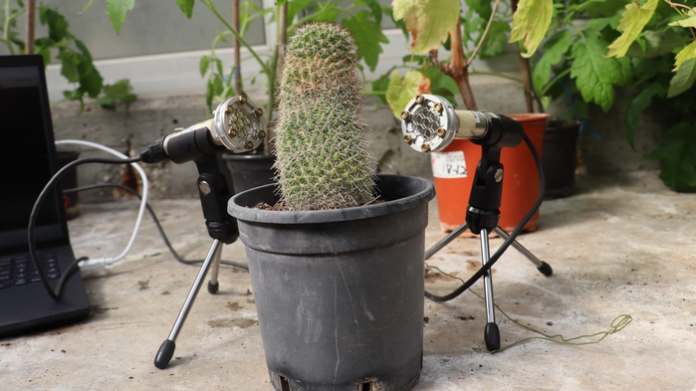JERUSALEM (VINnews) — Rabbi Nachman of Breslov pointed out in his writings that each and every blade of grass has “its own special tune”. Researchers at Tel Aviv University claim that they have identified the various sounds emitted by plants and have even succeeded in recording them, according to a Times Of Israel report.
Join our WhatsApp groupSubscribe to our Daily Roundup Email
It has been known for some time that plants communicate with one another, but the Israeli researchers claim that they’ve identified “words,” and found that different species speak in different “languages,” according to a groundbreaking new study published last Thursday in the prestigious scientific journal Cell.
Scientists already know that plants communicate in a variety of ways when they are stressed. They might change physically (by wilting or changing leaf color), become bitter to the taste (to deter herbivores), or emit smells (volatile organic compounds) to tell other members of the family that they are under attack, for example by insects.
One recent study showed that plants can respond to sound by, for instance, increasing the sugar concentration in their nectar to lure pollinators that are making a noise nearby.
However researchers now claim that for the first time they have recorded the sounds, which cannot be heard by human ears but are capable of being captured at high frequencies.
The plants apparently talk in clicks, much like the sound of popcorn popping, and scientists were able to recorded ultrasonic sounds, such as those emitted by tomato and tobacco plants that had been deprived of water, suffered a cut to the stem, or been left alone (as a control group).Ultrasonic sounds have a frequency of 20 to 150 kHz, which is above the limit of human hearing.
Prof. Lilach Hadany, from the university’s School of Plant Sciences and Food Security, who co-led the study, said, “We resolved a very old scientific controversy. We proved that plants do emit sounds!”
She went on, “Our findings suggest that the world around us is full of plant sounds and that these sounds contain information — for example about water scarcity or injury. We assume that in nature the sounds emitted by plants are detected by creatures nearby, such as bats, rodents, various insects, and possibly also other plants that can hear the high frequencies and derive relevant information.
“We believe that humans can also utilize this information, given the right tools — such as sensors that tell growers when plants need watering.
“Apparently, an apparently placid field of flowers can be a rather noisy place. It’s just that we can’t hear the sounds.”
“Our recordings indicated that the plants in our experiment emitted sounds at frequencies of 40 to 80 kilohertz,” said Hadany.
“Unstressed plants emitted less than one sound per hour, on average, while the stressed plants – both dehydrated and injured – emitted dozens of sounds every hour.”
The tomato plants, for example, made very little noise when watered, but in the subsequent four to five days, the number of sounds increased, then decreased, as the plants dried up.
Recordings were also made of sounds coming from tomato plants with tobacco mosaic virus.
To further test their findings, the team went on to carry out a small survey of additional plant species, successfully recording sounds from wheat, corn, Cabernet Sauvignon grapes, pincushion cacti, and henbit — the latter an annual plant from the mint family.
“We thus expect that many plants emit sounds, but the diversity of characteristics of these sounds is yet to be researched,” they write.
The researchers theorize that the sounds might be connected, partly at least, to cavitation in the stem. When a plant is under stress, air bubbles can form, expand and collapse in the xylem — the complex of tiny pipes that carry water and soluble materials from the roots to the stem and leaves.
The scientists conclude that the findings could have potential for precision agriculture — for example for monitoring water and disease, particularly as climate change causes more drought, threatening ecosystems and food security.
They also hold out the tantalizing prospect that other organisms might be able to “hear” and react to the sounds.
“The plant emissions that we report, in the ultrasonic range of 20 to 100 kHz, could be detected from a distance of three to five meters (10 to 16 feet) by many mammals and insects, given their hearing sensitivity, for example, mice and moths,” the paper says.
“We have shown that plant sounds can be effectively classified by machine learning algorithms. We thus suggest that other organisms may have evolved to classify these sounds as well and respond to them.”
“These findings can alter the way we think about the plant kingdom, which has been considered to be almost silent until now,” the paper concludes.


Perek Shira exquisitely describes Hashem’s creations, including plant-life, communicating and singing His praises. This extraordinary discovery is part of the many scientific discoveries of our epoch that point to the oneness that lies at the core of all of existence and the ‘soul’ that is present in all living things as taught by our Sages, particularly in the teachings of Kabbalah. Theses discoveries, prophesied in the Zohar Parshas Noach, are integral to the world’s spiritual evolution, culminating in the final Redemption when the world will be suffused with the knowledge of Hashem and G-dliness will be revealed within every aspect and dimension of life. May we merit Moshiach’s arrival without delay, celebrating Pesach b’Yerushalayim habnuyah, omein!
Hmm what will Vegans eat?
They don’t talk, they make noise.
rav hay gaon said he knew a yid who was able to understand sichas dekalim.